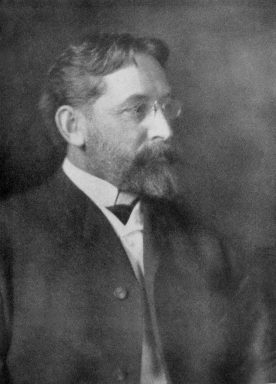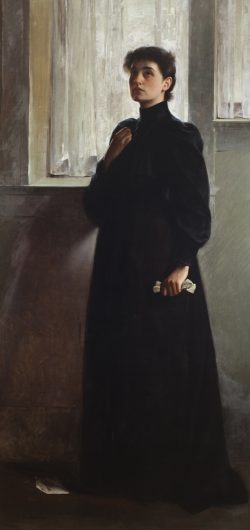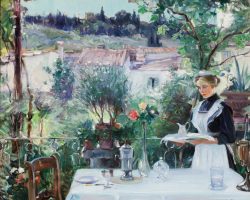Oliver Dennett Grover, from a photograph reproduced in Arthur Nicholas Hosking, “Oliver Dennett Grover, Painter,” The Sketch Book 5 (Sept. 1905).

Oliver Dennett Grover 1860–1927
Born in Earlville, Illinois, the son of a lawyer, Oliver Dennett Grover learned the rudiments of painting from portraitist Alden Finney Brooks. He moved with his family to Chicago as a boy and studied at the Chicago Academy of Design (predecessor of the Art Institute of Chicago) while attending secondary school. Following legal studies at the old University of Chicago, Grover used a small bequest to travel to Munich in 1879 to pursue a career in art. There he studied at the Royal Academy and joined the group of young Americans in the circle of the charismatic American artist Frank Duveneck. Traveling with Duveneck to Venice, Grover met James McNeill Whistler, who inspired him to pursue etching. Grover then studied further at the Académie Julian in Paris.
By the time he settled back in Chicago in 1887 with an appointment to the faculty of the fledgling Art Institute of Chicago, Grover had exhibited in prestigious venues in London, Paris, and Munich. In his hometown he stepped into leadership roles in local artists’ organizations, notably the Chicago Society of Artists. He made his debut as a large-scale painter by contributing to a monumental cyclorama painting of the Battle of Gettysburg under the direction of French artist Paul Philippoteaux. In 1889–1890 Grover assisted Albert Fleury in painting two murals in the theater of the new Auditorium Building and independently executed two lunette murals for the dining room of the adjacent hotel. Partnering with Ernest Albert, Grover established a decorative and scenic painting firm and worked on mural commissions, including projects for the Merchant Tailors Building at the 1893 World’s Columbian Exposition, the new Central Trust Company (later Chicago National Bank) building, to which L. C. Earle also contributed, and the southside Blackstone Library, the Chicago Public Library’s first branch facility.
As a member of the informal artists’ gathering known as the Little Room and its successor, the Cliff Dwellers club, Grover associated with such members of Chicago’s artistic elite as Ralph Clarkson and sculptor Lorado Taft; together, this trio “dominated almost dictatorially” Chicago’s art scene at the turn of the twentieth century, according to critic Clarence J. Bulliet.i One of the most public and prominent Chicago artists of his day, Grover received abundant local and national press attention as he showed his work in numerous group and solo exhibitions and received a host of awards and honors, culminating in election to associate membership in the National Academy of Design in New York. In addition to his mural work, Grover established a solid reputation as a painter of society portraits, and he was active as an etcher. In landscape painting he was best-known for his images of Italy; he traveled widely and later expanded his subject matter to the American West and the Canadian Rockies. At the time of his death, marked by a memorial exhibition at the Art Institute, Grover had come to symbolize embattled conservative artistic values. Bulliet, an outspoken champion of modernism, recalled him—with only a hint of irony—as “a man of fine culture, sensitive, and looking every inch the artist.”
Wendy Greenhouse, PhD
i C. J. Bulliet, “Artists of Chicago Past and Present. No. 96: Oliver Dennett Grover,” Chicago Daily News, July 22, 1939.

